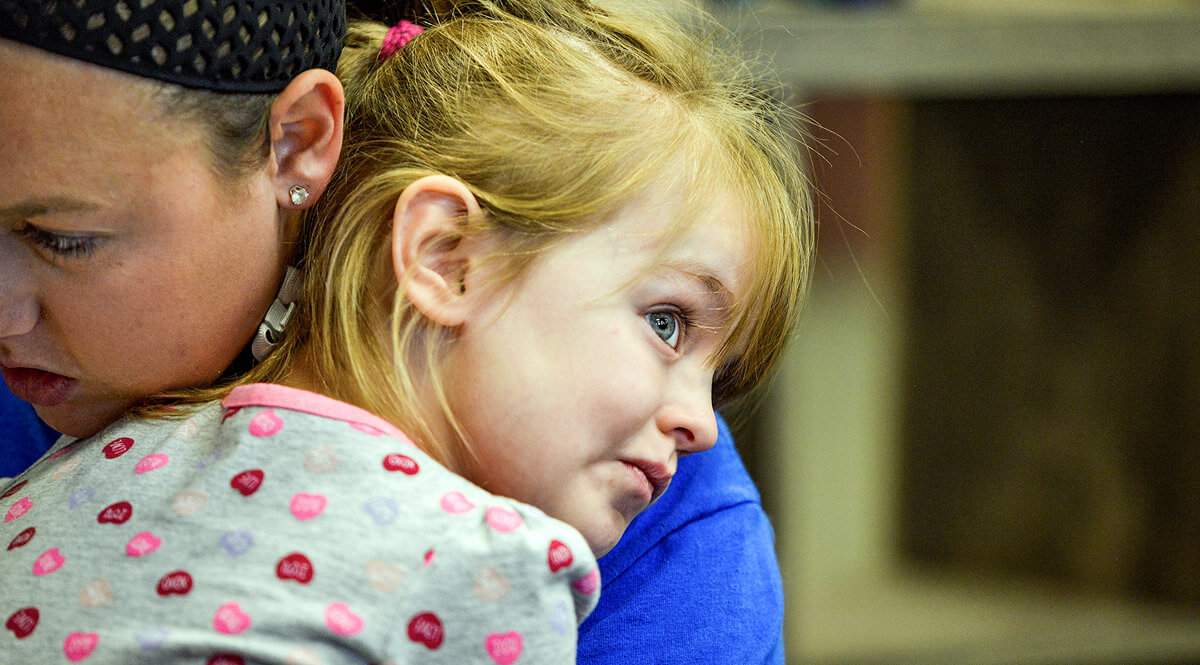How do you Keep my Child Safe During Autism Therapy? Learn from a Hopebridge BCBA
September 13, 2019
September 13, 2019

As parents, we know the well-being of your children is probably what keeps you up at night. Making sure they are safe when in arm’s reach is important, but you want to know they are protected when they are out of your sight as well. It can be extra stressful for families touched by autism spectrum disorder (ASD).
This thought is not lost on us at Hopebridge. The safety of your children is a priority here in our centers, which is why our teams are proactive on these measures through programming and training. To keep your minds at ease, as well as share a few tips for parents, Hopebridge Greenwood BCBA Kaitlin Rodrigues and Safety Care Trainer Jenna Timpson share how applied behavior analysis (ABA therapy) is designed to keep your children safe within our centers and beyond their walls.
The first step to keeping everyone safe in our centers is understanding that all behaviors – both positive and maladaptive – occur for a reason. Maladaptive behaviors are those we do not like to see; those traditionally considered “negative,” such as tantrums, self-injury (head-banging, biting, picking own skin, hair-pulling), eating non-consumable items (known as PICA), and aggressive behavior. When managing one of these more challenging behaviors, it is important we try to identify why it is taking place. In doing so, we can manage it with the least restrictive mode possible by proactively developing the skill set around any holes they may have.

Learning the reasons behind these behaviors helps us determine programming around those deficits so children on the spectrum can live more independently. For example, functional communication training could benefit a child by enabling them with the skills to more appropriately tell us what they need or want. Or another may need to build tolerating skills to transition away from preferred activities to another less preferred activity. By working on increasing independence, we do not have to be in their bubble as much, and therefore decrease the engagements that may frustrate them, which can lead to maladaptive behaviors.
One of the benefits of focusing on safety care is the strong focus on preventative measures to ultimately decrease maladaptive behaviors before they have the chance to arise. Everyone is safer when we can stop them before they start or deescalate them enough to remain hands off.
Here are some of the proactive efforts from Hopebridge in order to maintain safety in our centers:
On top of this, basic safety skills are naturally built into ABA programming. For example, teaching a child to hold someone’s hand while walking and respond when someone tells them to stop are skills we can teach. At a glance, these may not seem important, but without these skills, a community parking lot situation when you are with your child can suddenly become very unsafe.
Therapists are experienced in teaching children to follow directions and help them tolerate certain things that they may not be reinforcing or fun in order to help them and their families get through the day more fluidly. Taking advantage of the time we have in ABA, we can teach them on a basic level by tailoring the learning environment to each individual and breaking skills down into smaller steps. We know it might not go well at first, but comprehensive therapy allows us the time to commit to them, whereas parents may not have that luxury within the normal day-to-day routine.
We place our focus on teaching independence and practicing differential reinforcement so safety care procedures are only used when necessary. The way ABA is designed, BCBAs and RBTs are taught to use the least restrictive mode possible; only to use physical management if there is imminent harm for the individual.

While we take all the preventative actions we can, should there be an issue, every team member – BCBAs, RBTs, occupational therapists, speech therapists, clinic managers, etc. – is properly trained to handle a range of situations. This way everyone is on the same page should anything occur.
Hopebridge employs trainers to provide training within each center around the country. While the procedures are not often needed, housing this role internally, rather than hiring an external company, is a benefit because it provides the opportunity to ask questions, debrief and refresh skills more immediately and frequently as an extra layer of assurance. We also have a dedicated compliance department that is committed to ensuring safe and quality care for all of our children, families and team members.
When first entering ABA therapy, the majority of parents’ concerns lie around communication. This is very important, but even more important is maintaining their well-being. As we focus on functional communication, we first focus on safety through appropriate replacement behaviors. For instance, instead of throwing oneself to the floor when asked to finish with the TV or a device, we teach them to communicate, “can I have more time?” or “can I finish this show?”
Another question when we hear from parents enrolling their children in autism therapy is: “If my kid is in a center where all children are working on challenges, is my child going to pick up ‘bad’ behavior?”
Families may be worried their child will begin to exhibit a new maladaptive behavior after watching others, and while this is valid, it is our job to minimize the risk. That is one of the goals of differential reinforcement. Therapists keep their focus on these children to redirect them somewhere else and work to gain their attention in another way. We do not want the child participating in the maladaptive behavior to get all the attention, because the others may take it as a good thing and want it for themselves, especially those in the younger developing ages.
One of the biggest takeaways we have for parents in the safety arena is to reinforce positive behaviors. It is easy to forget that what we might consider as “negative attention” is still attention some will desire. By reprimanding a kid (which is not something we do at Hopebridge) for throwing a tantrum, you might actually be encouraging the behavior.
Another proactive measure is to be aware of potential triggers for your kid and plan for the unexpected. When out in the community or even at home, survey the area for potential hazards and be prepared to handle the challenges that might arise.
While it is important to look out for these triggers, you also do not want to avoid them. For instance, some parents know their child hates eating in the kitchen, so they let them sit on the couch, but escaping it often leads to a more difficult transition when we try to go back to it. Instead, work on it in steps. The first day, the parent could have them walk to the table, then back to the couch to eat. The next day, encourage the child to sit down at the table for a few seconds before heading back to the couch. Avoidance only strengthens the challenge, so work together to face it.

Parents participating in safety measures at home is a key to success
Taking advantage of parent training at Hopebridge can also lead to a more secure setting here in the center and at home. All of our programs are personalized for each family, so if there are more specific incidents you have questions about or want more explicit strategies, parent training is a great opportunity for you to have one-on-one time with your child’s BCBA.
Using preventative strategies is our first line of defense here in the centers, and it can be for you too. Be aware of triggers and proactively determine your plan so you are equipped to handle it when you are faced with those situations.
If you’re interested in learning more about how Hopebridge works to keep kids safe in and out of the centers through our ABA therapy program and other comprehensive services, please get in touch with us online to find a center near you.
*Informed consent was obtained from the participants in this article. This information should not be captured and reused without express permission from Hopebridge, LLC. Testimonials are solicited as part of an open casting call process for testimonials from former client caregivers. Hopebridge does not permit clinical employees to solicit or use testimonials about therapeutic services received from current clients (Ethics Code for Behavior Analysts 5.07-5.08; BACB, 2020). Hopebridge does not provide any incentives, compensation, or renumeration for testimonials provided by a former client or client caregiver.
Autism Therapy
September 30, 2018
What Does Center-Based Therapy Look Like? Learn from a Hopebridge BCBA
Autism Therapy
July 29, 2024
Hopebridge Partners with EarliPoint Health to Provide Objective Autism Assessment for Babies and Toddlers
Autism Therapy
January 13, 2020
New AAP Report States Early Intervention for Autism is Essential for Lifetime Development
Autism Therapy
June 03, 2022
Best Interview Questions for Autism Service Job Candidates to Ask